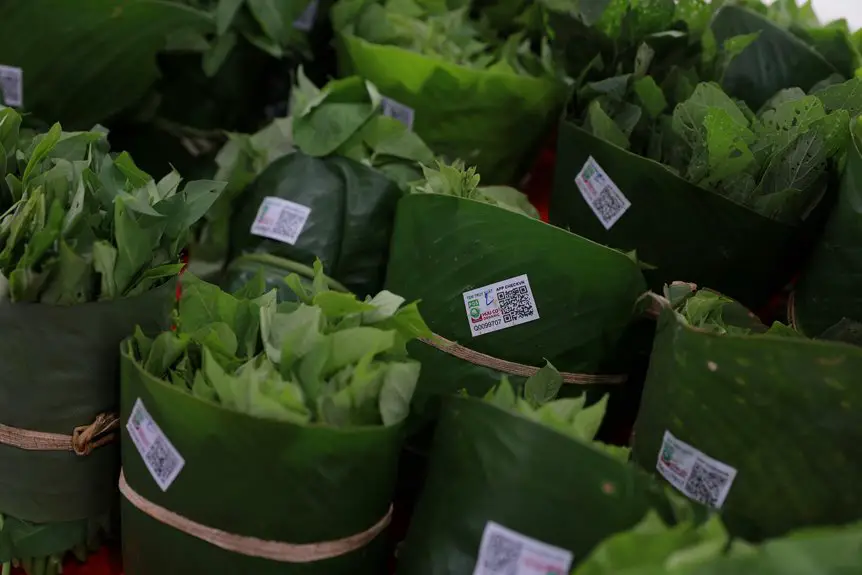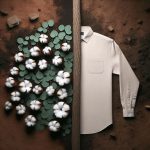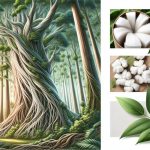When you consider sustainable fabrics, Tencel Luxe™ often comes up as a top contender. Its unique production process and material sourcing raise important questions about its environmental impact. Are the claims of reduced waste and lower water usage truly backed by evidence? As you explore the specifics, you might find some surprising comparisons to traditional textiles that could change your perspective on eco-friendly fashion. What sets Tencel Luxe™ apart in the sustainability conversation?
Table of Contents
Key Takeaways
- Tencel Luxe™ is made from sustainably sourced eucalyptus wood pulp, ensuring minimal environmental impact and responsible forestry practices.
- The closed-loop production process achieves over 99% solvent recovery, significantly reducing waste and harmful emissions during manufacturing.
- It uses approximately 50% less water in production compared to traditional cotton, promoting water conservation efforts.
- Tencel Luxe™ fibers are biodegradable, preventing long-term landfill issues and supporting a healthier ecosystem.
- Continuous innovations, such as water-efficient dyeing and biodegradable additives, enhance its sustainability credentials in the textile industry.
The Origins of Tencel Luxe
While many fabrics claim sustainability, Tencel Luxe™ stands out due to its carefully crafted origins. This premium lyocell is derived from sustainably sourced wood pulp, primarily from eucalyptus trees.
These trees are chosen for their rapid growth and minimal water usage, making them an eco-friendly choice. You’ll appreciate that the production process begins with selecting high-quality, renewable materials, ensuring that Tencel Luxe™ maintains its commitment to sustainability from the start.
Unlike conventional fibers, Tencel Luxe™ fibers undergo a unique process that enhances their softness and durability, resulting in a luxurious feel against your skin.
As you explore this fabric, you’ll find that its origins reflect a dedication to environmental responsibility, making it a preferred option for conscious consumers like you.
The Closed-Loop Production Process
In the closed-loop production process of Tencel Luxe™, solvent recycling efficiency plays an essential role in minimizing waste.
You’ll see how this method considerably reduces environmental impact while promoting sustainable resource management.
Understanding these aspects can help you appreciate the eco-friendly credentials of this premium lyocell.
Solvent Recycling Efficiency
As Tencel Luxe™ showcases its commitment to sustainability, the solvent recycling efficiency of its closed-loop production process stands out.
This innovative approach greatly reduces waste and resource consumption. Here’s what you need to know:
- Closed-loop system: The process recycles solvents, minimizing the need for fresh resources.
- High recovery rates: Tencel Luxe™ achieves over 99% solvent recovery, ensuring minimal environmental impact.
- Reduced emissions: By recycling solvents, the process limits harmful emissions associated with production.
- Resource conservation: The efficiency of solvent use means fewer raw materials are required, promoting sustainability.
This focus on solvent recycling efficiency not only enhances Tencel Luxe™’s sustainability profile but also sets a benchmark for the textile industry.
Reduced Environmental Impact
The closed-loop production process of Tencel Luxe™ considerably reduces environmental impact by ensuring that nearly all resources used are conserved and recycled.
In this system, solvents are captured, purified, and reused, minimizing waste and preventing harmful chemicals from entering the environment.
You’ll find that the process also emphasizes sustainable sourcing of raw materials, utilizing sustainably harvested wood from certified forests.
This approach not only lowers carbon emissions but also conserves water compared to traditional fiber production methods.
Additionally, the energy used in the process is sourced responsibly, further mitigating its ecological footprint.
Sustainable Resource Management
Tencel Luxe™ employs a remarkable closed-loop production process that exemplifies sustainable resource management.
This innovative approach minimizes waste and maximizes resource efficiency, ensuring that you’re making an environmentally conscious choice.
Here’s how the closed-loop process works:
- Sourcing: Wood pulp is sourced from sustainably managed forests.
- Dissolving: The cellulose is dissolved in a non-toxic solvent, which is then recycled.
- Spinning: The dissolved cellulose is spun into fibers, creating Tencel Luxe™.
- Recycling: The solvent is continuously recycled, reducing environmental impact.
Environmental Benefits of Tencel Luxe
While many fabrics contribute to environmental issues, Tencel Luxe™ stands out for its commitment to sustainability. This premium lyocell fiber is derived from sustainably sourced wood pulp, ensuring that forests remain healthy and thriving.
By using a closed-loop production process, Tencel Luxe™ minimizes waste and recycles water and solvents, greatly reducing environmental impact. The production of this fabric emits fewer greenhouse gases compared to traditional materials, helping combat climate change.
Plus, its biodegradable nature means it won’t linger in landfills for years. When you choose Tencel Luxe™, you’re opting for a fabric that not only feels luxurious but also supports a healthier planet. It’s a smart choice for the eco-conscious consumer.
Comparing Water Usage: Tencel Luxe vs. Traditional Cotton
Choosing sustainable fabrics goes beyond just their environmental benefits; it also involves understanding their resource demands.
When it comes to water usage, Tencel Luxe stands out compared to traditional cotton. Here’s how they stack up:
- Tencel Luxe: Uses approximately 50% less water in production.
- Traditional Cotton: Requires around 7,000 liters of water to produce just 1 kilogram of fiber.
- Tencel Luxe Process: Closed-loop system recycles water, minimizing waste.
- Environmental Impact: Less water usage means reduced strain on local water sources.
The Role of Sustainable Wood Sourcing
When considering Tencel Luxe™, it’s crucial to understand how sustainable wood sourcing plays a key role in its production.
You’ll want to look at certified forest management practices, which help minimize biodiversity impact and guarantee responsible sourcing initiatives.
Certified Forest Management Practices
Certified forest management practices play an essential role in guaranteeing that the wood used for Tencel Luxe™ is sourced sustainably, helping to protect biodiversity and reduce deforestation.
By adhering to these practices, companies can make a significant impact on the health of forests. Here’s how:
- Sustainable Harvesting: Only a portion of trees is cut down, allowing forests to regenerate naturally.
- Biodiversity Preservation: Practices prioritize the protection of various plant and animal species within forest ecosystems.
- Community Engagement: Local communities are involved in decision-making, fostering social responsibility.
- Certification Standards: Organizations like FSC (Forest Stewardship Council) guarantee wood comes from responsibly managed forests.
Reducing Biodiversity Impact
Sustainable wood sourcing plays an essential role in reducing biodiversity impact, ensuring that the extraction of raw materials doesn’t harm delicate ecosystems. By choosing responsibly managed forests, you support practices that maintain habitat integrity and promote wildlife conservation. This means that when you opt for products made from sustainably sourced wood, you’re directly contributing to the preservation of diverse species and their environments.
Moreover, sustainable sourcing often involves replanting trees and maintaining the forest’s natural balance, which enhances carbon sequestration and mitigates climate change effects. This holistic approach helps create a more resilient ecosystem.
Ultimately, by being mindful of your choices, you can help safeguard the planet’s biodiversity while enjoying high-quality materials like Tencel Luxe™.
Sustainable Sourcing Initiatives
While many consumers seek eco-friendly products, understanding the role of sustainable sourcing initiatives can greatly impact your choices.
When it comes to Tencel Luxe™, the sourcing of wood plays a vital role in its sustainability. Here are four key aspects to take into account:
- Certified Forests: Tencel Luxe™ sources wood from sustainably managed forests, ensuring biodiversity and ecosystem health.
- Transparency: Brands often provide clear information about where and how their wood is sourced, giving you confidence in your purchase.
- Reduced Waste: Sustainable initiatives focus on using by-products from other industries, minimizing waste.
- Reforestation Efforts: Many companies invest in reforestation projects, helping to restore ecosystems and combat climate change.
Market Trends and Demand for Sustainable Fabrics
As consumers become more conscious of their environmental impact, the demand for sustainable fabrics has surged dramatically. Brands are responding by integrating eco-friendly materials into their collections, revealing a clear trend toward sustainability. You’ll notice that consumers prioritize transparency, ethical sourcing, and reduced carbon footprints when making purchase decisions.
Here’s a quick overview of the market trends:
| Trend | Consumer Interest | Brand Adaptation |
|---|---|---|
| Organic Materials | High | Increasingly Popular |
| Recycled Fabrics | Medium | Growing Awareness |
| Certifications | High | Essential for Trust |
This shift isn’t just a fleeting trend; it’s reshaping the fashion industry and pushing for a more sustainable future.
Future Innovations in Tencel Luxe Sustainability
Innovations in Tencel Luxe™ are set to redefine sustainability in the textile industry.
Innovations in Tencel Luxe™ are poised to transform sustainability within the textile sector.
As you explore the future of this premium lyocell, you’ll find exciting advancements on the horizon that promise to enhance its eco-friendliness.
Here are some key innovations you can expect:
- Closed-loop production processes – Reducing waste and emissions by recycling solvents used in manufacturing.
- Biodegradable additives – Integrating natural substances to further improve the fiber’s environmental impact.
- Water-efficient dyeing techniques – Minimizing water usage during the dyeing process, making it more sustainable.
- Enhanced traceability – Using blockchain technology to track the supply chain, ensuring greater transparency and ethical sourcing.
These innovations could greatly elevate Tencel Luxe™ as a leader in sustainable textiles.
Frequently Asked Questions
How Does Tencel Luxe Compare to Other Sustainable Fabrics?
When you explore sustainable fabrics, think of Tencel Luxe as the elegant swan among ducks. It boasts superior softness, breathability, and eco-friendly production, making it a standout choice compared to other materials in the sustainable domain.
Can Tencel Luxe Be Recycled After Use?
Yes, Tencel Luxe can be recycled after use. You can return it to specialized recycling facilities that handle lyocell fibers, allowing you to contribute to a circular economy and reduce environmental impact.
What Certifications Does Tencel Luxe Hold for Sustainability?
Tencel Luxe holds several sustainability certifications, including the EU Ecolabel and FSC certification. These certifications guarantee that the fibers are sourced responsibly and produced with minimal environmental impact, so you can feel good about your choices.
Is Tencel Luxe Suitable for Sensitive Skin?
Imagine a gentle breeze caressing your skin; that’s what Tencel Luxe feels like. It’s soft, hypoallergenic, and breathable, making it perfect for sensitive skin. You’ll enjoy comfort and care without irritation or discomfort.
How Does Tencel Luxe’s Production Impact Local Communities?
Tencel Luxe’s production can create job opportunities and stimulate local economies. However, it’s essential to guarantee sustainable practices are used, so communities benefit without facing environmental degradation or adverse health effects from manufacturing processes.
- The Use of Nonwovens in Construction and Civil Engineering - July 11, 2025
- The Use of Nonwovens in Construction and Civil Engineering - July 11, 2025
- The Use of Nonwovens in Construction and Civil Engineering - July 11, 2025







